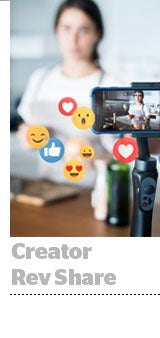Facebook is putting out the welcome mat for professional content creators by diversifying the ways they can earn revenue on the platform.
Creators can pursue up to four different revenue streams. They can set up subscriber-only paid groups, receive “stars” as tips from fans, rent their audience to their branded content partners and share in video ad revenue for mid-roll, pre-roll and image ads.
The four options for creators – some still in early testing phases – signal how Facebook is trying to entice more video creators to its platform. Some of the monetization options are new to Facebook but already well-established on platforms like Twitch or YouTube.
Facebook is making these monetization announcements at VidCon, a conference that attracts video creators. But the monetization options apply to all creators, including enterprise media brands.
Subscription revenue
Facebook is giving creators the option to form subscription-only groups for their fans. Users pay to gain access to the influencer’s unique content.
The dad humor Facebook page LadBaby, for example, a page with 3.5 million fans, has convinced a few thousand of its followers to pay a monthly fee for extra videos of dad vlogger Mark Hoyle raising his family with a sense of humor.
“The subscription service allows us to get closer to the biggest followers,” Hoyle said, who runs the account with his wife. He recognizes subscribers by their first name as fans who watch and comment on every video.
Creators like LadBaby keep 70% of the subscription fee. Only a portion of the remaining 30% goes to Facebook.
When users sign up on their phones, Apple and Android take a 30% mobile payment cut the first year. So Facebook is taking zero percent in order to entice creators onto the platform. In year two, when Apple and Android reduce their cut to 15%, Facebook will take 15%. On desktop, Facebook gets the full 30%.
No matter the scenario, the creator keeps their 70%.
“Stars” tips
Twitch popularized the idea of “bits,” money given as a tip to favorite streamers. Facebook said that it’s been testing a similar one-time payment system among its gaming creators. Followers of a creator can “tip” the person in stars. Early traction convinced Facebook to test the idea more broadly with more types of video creators.
Facebook takes a variable cut on stars – more for small “star packs,” and less for big ones. As with subscription revenue, it takes its share on mobile after Apple and Android take their cut.
Stars are equivalent to one cent in US dollars. Facebook takes a variable percentage that starts around 29% and decreases to roughly 5% with larger star purchases.
Branded content workflow
At last year’s VidCon, Facebook introduced an end-to-end workflow management tool for brands and creators to assist with every step of influencer marketing, from finding the right creators to optimizing and reporting on campaigns.
“The vision for brand collaboration manger is a one-stop shop for branded content,” said Kate Orseth, Facebook director of media monetization.
This year, it’s added a data sharing capability that makes it easier to amplify branded content. When brands want to make an ad out of a creator’s sponsored post, creators can share their audience with a brand. They can then amplify the creator-authored posts using its brand account.
While creators have been doing this before, either by amplifying branded content themselves or sharing admin access with creators, this improvement makes sharing seamless.
Facebook has also introduced a dashboard for creators that shows audience information such as churn rates, viewing behaviors and demographics as well as information around how their videos are monetizing and what videos are eligible for ads.
Pre-roll, mid-roll and image ads
Facebook is also adding two new types of ads to monetize creators’ videos. In addition to mid-roll ads, creators can run pre-roll ads for content that can’t be interrupted – think a music video.
Facebook is also adding image ads – which include image and text that appear below video content– to accompany videos where ads similarly can’t be interruptive.
The changes will make it easier for creators who don’t make five-minute to seven-minute videos that work best for mid-roll ads. But mid-roll ads are working: The number of pages that use ad breaks tripled over the past year as Facebook shares in the ad revenue from its content.














